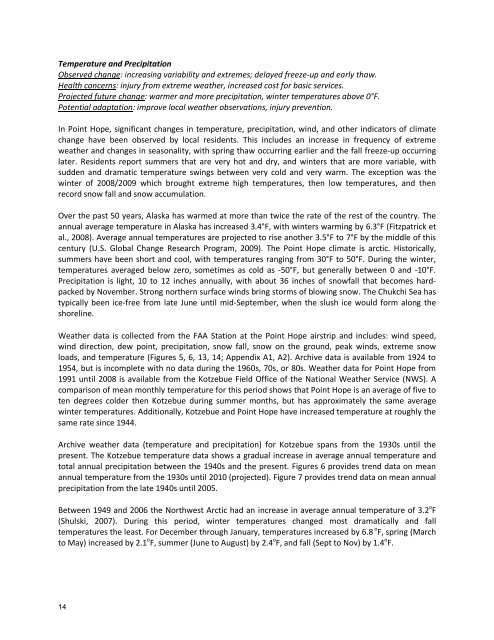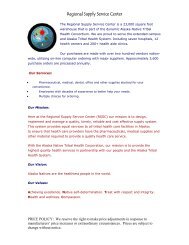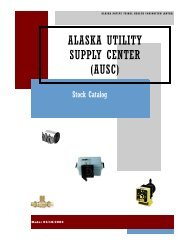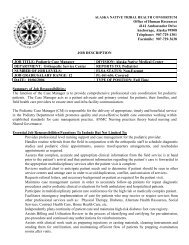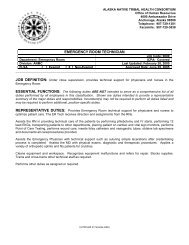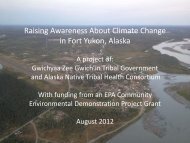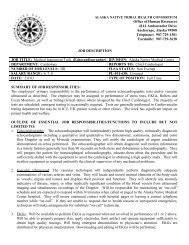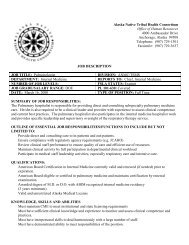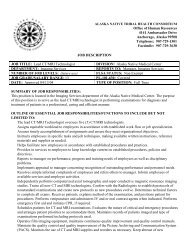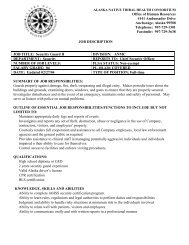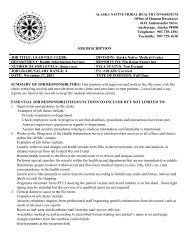Draft Final Climate Change and Health Impacts Point ... - ANTHC
Draft Final Climate Change and Health Impacts Point ... - ANTHC
Draft Final Climate Change and Health Impacts Point ... - ANTHC
You also want an ePaper? Increase the reach of your titles
YUMPU automatically turns print PDFs into web optimized ePapers that Google loves.
Temperature <strong>and</strong> Precipitation<br />
Observed change: increasing variability <strong>and</strong> extremes; delayed freeze‐up <strong>and</strong> early thaw.<br />
<strong>Health</strong> concerns: injury from extreme weather, increased cost for basic services.<br />
Projected future change: warmer <strong>and</strong> more precipitation, winter temperatures above 0°F.<br />
Potential adaptation: improve local weather observations, injury prevention.<br />
In <strong>Point</strong> Hope, significant changes in temperature, precipitation, wind, <strong>and</strong> other indicators of climate<br />
change have been observed by local residents. This includes an increase in frequency of extreme<br />
weather <strong>and</strong> changes in seasonality, with spring thaw occurring earlier <strong>and</strong> the fall freeze‐up occurring<br />
later. Residents report summers that are very hot <strong>and</strong> dry, <strong>and</strong> winters that are more variable, with<br />
sudden <strong>and</strong> dramatic temperature swings between very cold <strong>and</strong> very warm. The exception was the<br />
winter of 2008/2009 which brought extreme high temperatures, then low temperatures, <strong>and</strong> then<br />
record snow fall <strong>and</strong> snow accumulation.<br />
Over the past 50 years, Alaska has warmed at more than twice the rate of the rest of the country. The<br />
annual average temperature in Alaska has increased 3.4°F, with winters warming by 6.3°F (Fitzpatrick et<br />
al., 2008). Average annual temperatures are projected to rise another 3.5°F to 7°F by the middle of this<br />
century (U.S. Global <strong>Change</strong> Research Program, 2009). The <strong>Point</strong> Hope climate is arctic. Historically,<br />
summers have been short <strong>and</strong> cool, with temperatures ranging from 30°F to 50°F. During the winter,<br />
temperatures averaged below zero, sometimes as cold as ‐50°F, but generally between 0 <strong>and</strong> ‐10°F.<br />
Precipitation is light, 10 to 12 inches annually, with about 36 inches of snowfall that becomes hardpacked<br />
by November. Strong northern surface winds bring storms of blowing snow. The Chukchi Sea has<br />
typically been ice‐free from late June until mid‐September, when the slush ice would form along the<br />
shoreline.<br />
Weather data is collected from the FAA Station at the <strong>Point</strong> Hope airstrip <strong>and</strong> includes: wind speed,<br />
wind direction, dew point, precipitation, snow fall, snow on the ground, peak winds, extreme snow<br />
loads, <strong>and</strong> temperature (Figures 5, 6, 13, 14; Appendix A1, A2). Archive data is available from 1924 to<br />
1954, but is incomplete with no data during the 1960s, 70s, or 80s. Weather data for <strong>Point</strong> Hope from<br />
1991 until 2008 is available from the Kotzebue Field Office of the National Weather Service (NWS). A<br />
comparison of mean monthly temperature for this period shows that <strong>Point</strong> Hope is an average of five to<br />
ten degrees colder then Kotzebue during summer months, but has approximately the same average<br />
winter temperatures. Additionally, Kotzebue <strong>and</strong> <strong>Point</strong> Hope have increased temperature at roughly the<br />
same rate since 1944.<br />
Archive weather data (temperature <strong>and</strong> precipitation) for Kotzebue spans from the 1930s until the<br />
present. The Kotzebue temperature data shows a gradual increase in average annual temperature <strong>and</strong><br />
total annual precipitation between the 1940s <strong>and</strong> the present. Figures 6 provides trend data on mean<br />
annual temperature from the 1930s until 2010 (projected). Figure 7 provides trend data on mean annual<br />
precipitation from the late 1940s until 2005.<br />
Between 1949 <strong>and</strong> 2006 the Northwest Arctic had an increase in average annual temperature of 3.2 o F<br />
(Shulski, 2007). During this period, winter temperatures changed most dramatically <strong>and</strong> fall<br />
temperatures the least. For December through January, temperatures increased by 6.8 o F, spring (March<br />
to May) increased by 2.1 o F, summer (June to August) by 2.4 o F, <strong>and</strong> fall (Sept to Nov) by 1.4 o F.<br />
14


